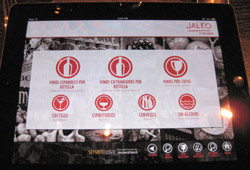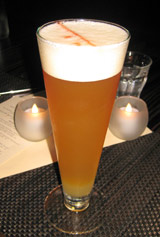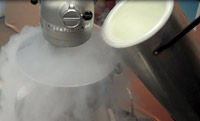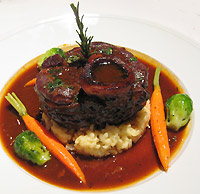While food production and preparation have been aided by advancing technology, iPads, Androids and ever-evolving social media are now connecting food and foodies in all sorts of interesting ways. America still loves farm-to-table menus and the comfort of burgers and Italian food including pizza. But Peru is bursting onto the cuisine scene with the rise in popularity of ceviche and pisco (grape brandy). While we are thinking about drinking, beer pairings and cocktails are reinventing everything we thought we knew about the brew. And move over molecular gastronomy, America's most creative chefs are evolving a new Progressive American Cuisine.
Putting the App in Appetite
 |
Top sommeliers are using iPad wine lists |
If you think fine dining will whisk you away from your computer and into a civilized realm, think again. Instead of a charmingly worn, twenty-pound wine tome that some of us are still perversely fond of, your sommelier may now hand over a slender iPad that can not only hold 3,000 choices but also provide links to reviews, tasting profiles, vineyards and vintages. Some eateries may even dispense with a human expert altogether, since iPads offer less attitude. And remember that drawer at home stuffed full of menus? Now restaurants save trees with online ordering from your computer or phone, and also connect us with group discounts, web specials and Facebook rewards for "liking" them. The passenger pigeon may be long gone, but Twitter brings foodies into the moment as restaurants tweet specials, chefs post their latest farmers market finds, and fans post photos of favorite (or hated!) dishes. Diners can follow their favorite chefs and restaurant critics on Twitter; Gordon Ramsay has over half a million followers. Ultimately, Facebook, Twitter and a host of other social media offer killer marketing at extremely low cost — something everyone in this era of financial uncertainty can sing about.
The Rise of Peru
Peruvian food has entered the spotlight, graduating from cute ethnic neighborhood spots to chic eateries that bring this ancient South American cuisine to a contemporary haute level. While star chef Nobu Matsuhisa may have been the maverick to bring his Japanese Peruvian fusion to Matsuhisa many years ago, a new Peruvian craze is just taking off. Ceviche — the national dish of Peru — dots contemporary menus of different genres, as chefs embrace the piquant way citrus complements the flavor of fish. Ricardo Zarate's hot restaurant Picca in Los Angeles (one of our 2012 Top 10 Insider Picks) has helped popularize Peruvian standards beyond ceviche — like tiradito (another marinated sliced raw fish) and anticuchos, or skewered meats. At famed Peruvian chef Gastón Acurio's first U.S. restaurant, La Mar Cebichería Peruana in San Francisco, diners enjoy the traditional Peruvian stir-fry lomo saltado and causas, artfully presented scoops of creamy whipped potatoes topped with seafood, a soothing twist on the meat-and-potatoes theme. He recently opened a New York branch (in the former Tabla space), with sophisticated menu items like tuna tartare with wasabi aïoli and flying fish roe, blue shrimp in a crispy sweet potato crust, and duck confit with beer-cooked rice. But we don't think the Peruvian favorite cuy, or roast guinea pig, will prove popular in North America.
Pisco, the famous type of brandy of Peru, is the oldest distilled spirit native to the Americas, originally made from grapes brought by conquistadors. Pisco came to California during the gold rush, and Mark Twain was among its fans. While the Pisco Sour cocktail became popular in America in the 1920s, artisanal pisco cocktails with South American flair are now showing off a wide range of ingredients from cumin and ginger to fresh blackberry, cucumber and jalapeño. Today, pisco is being updated all over the country in hip venues like Peels on Bowery in NYC. At Richard Sandoval's Zengo in Washington, D.C., the bartenders might whip up a sparkling saké pisco cocktail.
Beer Cocktails and Beer Pairings
 |
You'd be surprised what's going into cocktails these days! |
Beer cocktails are reaching beyond snakebites and micheladas, leaving the boilermaker in the dust. Beer is now being mixed with gin, vodka and bourbon for effervescent cocktails that celebrate a bit of the common man's bubbly. In New York at The Breslin Bar & Dining Room, you can get a beer cocktail called the Beggar's Banquet made with bourbon, lemon juice and maple syrup. On the other coast, Santa Monica's Cezanne makes a Cherry Wheat Mimosa out of Blue Moon, Chambord and orange juice, while San Francisco's Aziza serves up a concoction of muddled beets, pilsner, gin, dry vermouth and lime juice known simply as the Beet. The staple of the six-pack has not only moved uptown in terms of cocktails this year, but beer pairings at finer restaurants are now becoming more common due to an increased popularity of craft beers and microbrews. We're not sure if this is because of, or the reason for, the ongoing mushrooming of the gastropub in cities coast to coast, another continuing trend for 2012! But beer lovers come running as long as the taps keep flowing, and in these uncertain financial times the combination of beer, comfort food and a lower price point is a better bet than anything offered on Wall Street. And who can resist the great beer names like Old Howling Bastard, Toxic Sludge, Wasatch Polygamy Porter, Avery Collaboration Not Litigation or Ridgeway Santa's Butt? Not us!
Molecular Becomes Progressive
 |
Chef using liquid nitrogen – don't try this at home! |
While many forward-thinking American foodies have embraced the adventure of molecular gastronomy, a number of vanguard chefs are now moving it forward under a new guise. Grant Achatz, who created the palace of what we might call America's molecular movement at Chicago's Alinea, prefers to have his cooking known as Progressive American Cuisine. Since Ferran Adrià's elBulli closed its doors, molecular gastronomy continues to evolve. Chefs like René Redzepi of Noma in Copenhagen gravitate to more of an organic wildcrafting style fused with an almost archeological cooking approach that seeks to explore and often recapture national cooking traditions and origins. This is by no means any less “inventive” and American chefs have seized on this new progressive ideology to bring it even further — and make it more approachable to diners at the same time. For chefs like Daniel Patterson at Coi, David Kinch at Manresa, Sean Brock at McCrady's, Dominique Crenn at Atelier Crenn (one of our 2012 Top 10 New Restaurants), Edward Lee at 610 Magnolia and José Andrés, the emphasis may still be on the shock of the new in terms of invention and contrast, but with dishes that eschew liquid nitrogen, carbon dioxide and emulsifiers for age-old ingredients like hay and pine needles. Redzepi has even been known to use reindeer blood!
Continuing Trends – Farm-to-Table, Comfort Food, Italian Nostalgia
 |
Osso buco: Italian food is comfort food |
At the other extreme of technology we continue to embrace a natural farm-to-table ethos that is spreading beyond fine dining restaurants and into corner cafés and neighborhood lunch spots. More and more menus are including seasonal produce and locally-caught, sustainable seafood and boasting the small farms and purveyors they utilize. Even the restaurant roof garden has sprouted in unlikely urban places. Burgers continue to rule the carnivore kingdom, especially in this economy, and burger chains are expanding countrywide. Pizza remains ever popular; while chefs keep experimenting with delightfully surprising new toppings, breakfast/brunch pizza is a new gourmet trend from San Francisco (Beretta) to New Orleans (Mondo, which offers a bacon, egg and ricotta pizza) to Portland (Sunshine Tavern). Comfort food with an Italian accent brings us old favorites like osso buco and arancini. And while it evokes nostalgia and comfort, Italian food also continues to grow in many directions. Regional Italian eateries keep bringing us revelations from places like Piedmont and Liguria, and nifty new pasta shapes surprise us. Mario Batali's Italian marketplace megastore, Eataly, has deliriously seduced New Yorkers, and the Roman mozzarella bar chain Obika is now a mall fixture. Perhaps Italy's best culinary legacy is that of Slow Food whose 1980s manifesto has now become part of the fabric of American locavorism. In this country that created the Big Mac, the stunning growth of the organic industry, the resurgence of heirloom crops and the support of small farmers by chefs and shoppers alike are currently at its peak, and shows no sign of slowing.
 With GAYOT's lists of the Best Vegetarian-Friendly Restaurants, you can discover where to find the best meatless meals.
With GAYOT's lists of the Best Vegetarian-Friendly Restaurants, you can discover where to find the best meatless meals. With GAYOT's lists of the Best Vegetarian-Friendly Restaurants, you can discover where to find the best meatless meals.
With GAYOT's lists of the Best Vegetarian-Friendly Restaurants, you can discover where to find the best meatless meals.